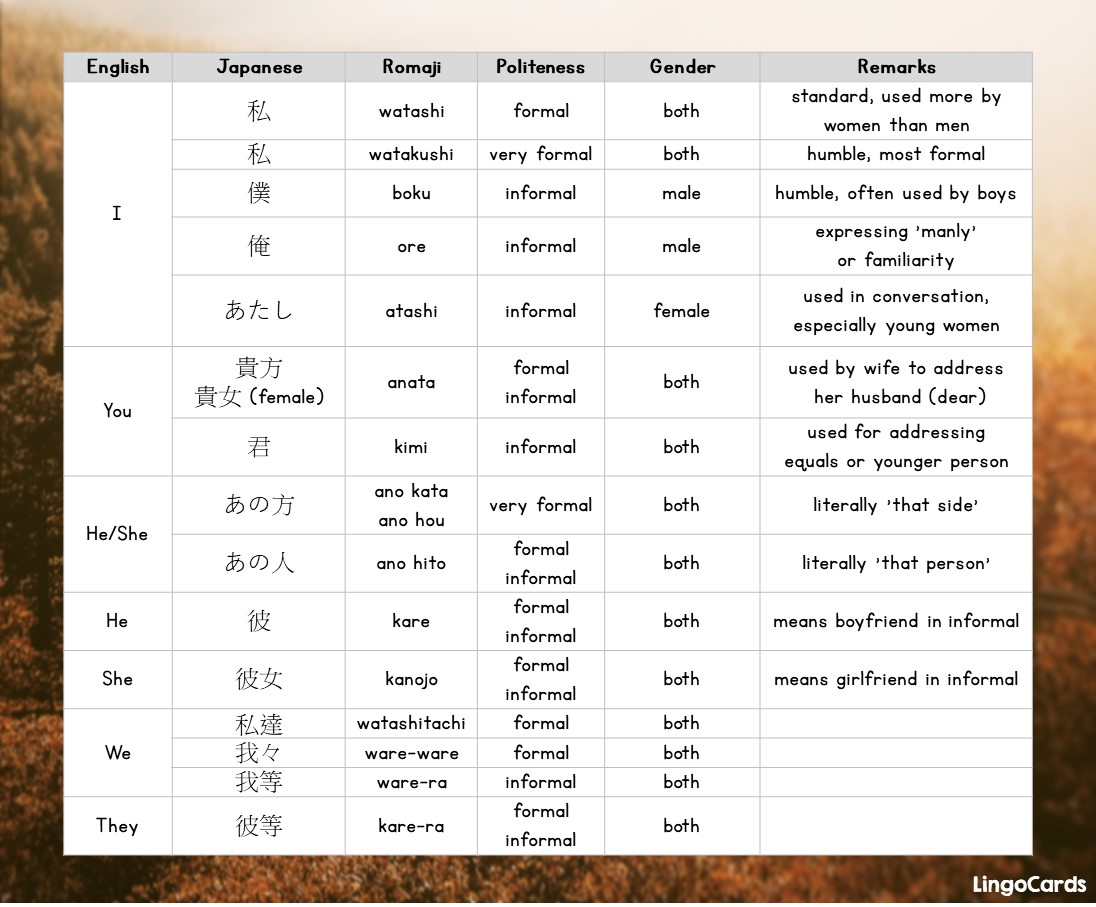
Just as in Spanish and Italian, pronouns in Japanese are generally omitted in the conversation if the meaning of the sentence is clear without them. For example, the verb あげる (ageru) implies that ‘somebody close to me’ or ‘I’ give something to someone. In this case, pronouns are not required in the sentence. On the other hand, the word for ‘you’ in Japanese あなた (anata), is rarely used to refer to the second person. It can be considered rude and inappropriate.
Addressing People in Japanese
Instead of using pronouns – I, you, he, she, we, they – for addressing people in Japanese, try to refer people using their name and followed by the honorifics titles. The commonly used name suffixes including:
-さん (-san) → the most common, neutral.
-様 (-sama) → formal version of -さん (-san), and for refer customer – お客様 (okyaku-sama).
-ちゃん (-chan) → informal, generally for female.
-君 (-kun) → informal, generally for male.
-先生 (-sensei) → teachers, lawyers, doctors or someone who has achieved mastery in some skills.
-先輩 (-senpai) → seniors in academics or learning environment.
*Note: There is a word, 後輩 (kōhai) to describe juniors in academics or learning environment. However, it’s not used for addressing people.
In the circumstances when you are not sure which one to choose, use the person’s last name along with -さん (-san). It is the most common honorific title that similar to ‘Mr, Ms, Mrs’. Contrarily, use -ちゃん (-chan) and -君 (-kun) titles only for addressing people that you are close with or kids.
Subject Pronouns in Japanese
When it is necessary to state the pronouns, either in a written context or for emphasis, use the following pronouns.

Note that there is no translation of ‘it’ in Japanese – similar to spoken Brazilian Portuguese.
Read: Demonstrative Pronouns in Japanese
Object Pronouns in Japanese
Just like nouns in Japanese, pronouns also only have one form in Japanese. In other words, subject pronouns and object pronouns in Japanese are the same. Thus, 私 (watashi) means both ‘I’ and ‘me’; 彼 (kare) means both ‘he’ and ‘him’; and so on. Therefore, it is important to understand how to use the Japanese particles. Thus:
私は彼を探した。
Watashi wa kare o sagashita.
I looked for him.
彼は私を探した。
Kare wa watashi o sagashita.
He looked for me.
Possessive Pronouns in Japanese
There are no direct translations for ‘my, your, his, her, our, their’ in Japanese. Possessive pronouns are formed simply by placing the particle の (no) after the pronouns.
Structure: Subject/Object Pronoun + の
Examples:
私の名前はサラです。
Watashi no namae wa sara desu.
My name is Sarah.
彼の車です。
Kare no kuruma desu.
It is his car.
Let’s learn Japanese today! Join us at LingoCards!